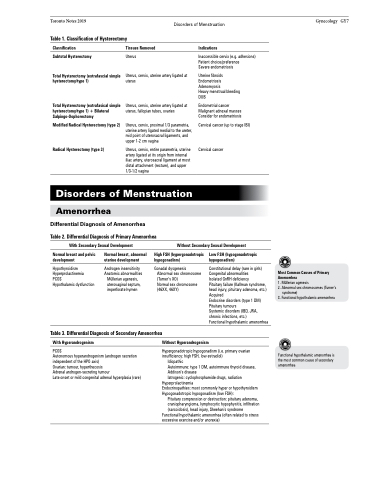Page 493 - TNFlipTest
P. 493
Toronto Notes 2019
Disorders of Menstruation
Gynecology GY7
Table 1. Classification of Hysterectomy
Classification
Subtotal Hysterectomy
Total Hysterectomy (extrafascial simple hysterectomy/type 1)
Total Hysterectomy (extrafasical simple hysterectomy/type 1) + Bilateral Salpingo-Oophorectomy
Modified Radical Hysterectomy (type 2)
Radical Hysterectomy (type 3)
Tissues Removed
Uterus
Uterus, cervix, uterine artery ligated at uterus
Uterus, cervix, uterine artery ligated at uterus, fallopian tubes, ovaries
Uterus, cervix, proximal 1/3 parametria, uterine artery ligated medial to the ureter, mid point of uterosacral ligaments, and upper 1-2 cm vagina
Uterus, cervix, entire parametria, uterine artery ligated at its origin from internal iliac artery, uterosacral ligament at most distal attachment (rectum), and upper 1/3-1/2 vagina
Indications
Inaccessible cervix (e.g. adhesions) Patient choice/preference
Severe endometriosis
Uterine fibroids Endometriosis Adenomyosis
Heavy menstrual bleeding DUB
Endometrial cancer Malignant adnexal masses Consider for endometriosis
Cervical cancer (up to stage IBI)
Cervical cancer
Disorders of Menstruation
Amenorrhea
Differential Diagnosis of Amenorrhea
Table 2. Differential Diagnosis of Primary Amenorrhea
With Secondary Sexual Development
Without Secondary Sexual Development
Normal breast and pelvic development
Hypothyroidism Hyperprolactinemia
PCOS
Hypothalamic dysfunction
Normal breast, abnormal uterine development
Androgen insensitivity Anatomic abnormalities Müllerian agenesis, uterovaginal septum,
imperforate hymen
High FSH (hypergonadotropic hypogonadism)
Gonadal dysgenesis Abnormal sex chromosome (Turner’s XO)
Normal sex chromosome (46XX, 46XY)
Low FSH (hypogonadotropic hypogonadism)
Constitutional delay (rare in girls) Congenital abnormalities
Isolated GnRH deficiency
Pituitary failure (Kallman syndrome, head injury, pituitary adenoma, etc.) Acquired
Endocrine disorders (type 1 DM) Pituitary tumours
Systemic disorders (IBD, JRA, chronic infections, etc.)
Functional hypothalamic amenorrhea
Most Common Causes of Primary Amenorrhea
1. Müllerian agenesis
2. Abnormal sex chromosomes (Turner’s
syndrome)
3. Functional hypothalamic amenorrhea
Functional hypothalamic amenorrhea is the most common cause of secondary amenorrhea
Table 3. Differential Diagnosis of Secondary Amenorrhea
With Hyperandrogenism
PCOS
Autonomous hyperandrogenism (androgen secretion independent of the HPO axis)
Ovarian: tumour, hyperthecosis
Adrenal androgen-secreting tumour
Late onset or mild congenital adrenal hyperplasia (rare)
Without Hyperandrogenism
Hypergonadotropic hypogonadism (i.e. primary ovarian insufficiency: high FSH, low estradiol)
Idiopathic
Autoimmune: type 1 DM, autoimmune thyroid disease, Addison’s disease
Iatrogenic: cyclophosphamide drugs, radiation
Hyperprolactinemia
Endocrinopathies: most commonly hyper or hypothyroidism Hypogonadotropic hypogonadism (low FSH):
Pituitary compression or destruction: pituitary adenoma, craniopharyngioma, lymphocytic hypophysitis, infiltration (sarcoidosis), head injury, Sheehan’s syndrome
Functional hypothalamic amenorrhea (often related to stress excessive exercise and/or anorexia)


